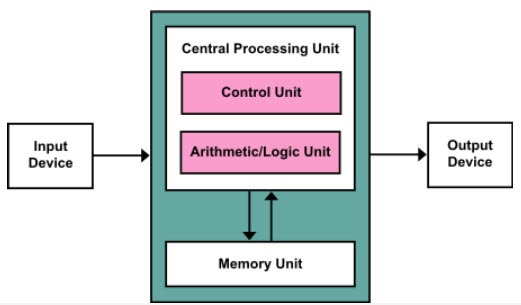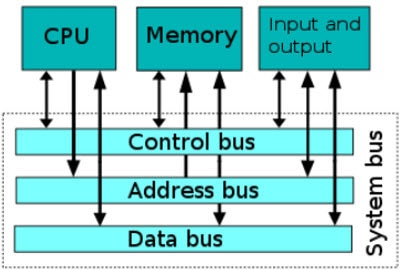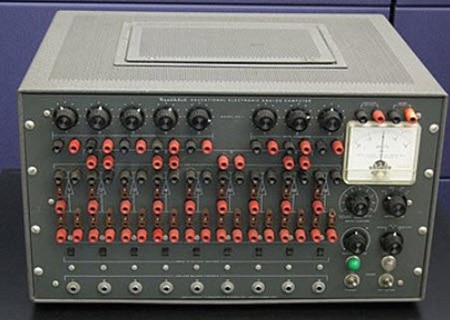Analog Computing: The Original Computers
2024-02-05 | By Antonio Velasco
Today, the computing landscape is dominated by binary, processed through complex digital logic through the Von Neumann architecture. Despite its undeniable prowess, this digital paradigm carries inherent limitations. Enter analog computing, a forgotten but resurgent paradigm that promises to overcome these barriers using nothing but passive components and the timeless laws of Ohm and Kirchhoff. Through this blog, we'll talk about the limitations of digital computation, how analog computing works (and what it even is), and how to solve problems ranging from the simple to the highly complex, including differential equations.
So, How Do Today's Computers Work?
Today's computers utilize digital logic and the Von Neumann Architecture.

Digital logic processes information as binary code—zeros and ones. It's efficient for tasks like data storage, Boolean operations, and precise arithmetic. An input is translated into basic 0's and 1's, which is processed through a CPU and an ALU. The Von Neumann architecture takes this a step further, utilizing a memory unit allowing the computer more versatility and programmability.

However, as powerful as digital computing is, it faces intrinsic limitations:
- Digital computing operates on discrete values, leading to quantization errors in approximating continuous phenomena. For tasks involving real-world signals, such as analog sensor data or physical simulations, this can result in inaccuracies.
- To tackle complex problems, digital systems often require intricate algorithms and extensive memory. This leads to computational inefficiencies, especially when dealing with tasks like real-time control or simulations of continuous systems.
Where Analog Computing Comes In
Analog signals are essentially signals that can take on a wide range of values--not just 0's and 1's. Analog computing utilizes variable values that can be produced through a combination of electronics--voltages and signals. This makes analog computing relatively simple, as it just relies on passive components and basic circuit equations. The memory requirement is a lot lower, and there is no need for complex algorithms to get around the limitation of just using 0's and 1's.
By working directly with continuous signals, it minimizes quantization errors, making it suitable for applications such as signal processing, control systems, and scientific simulations. Analog computers can solve complex problems efficiently. They can tackle tasks like solving differential equations or optimizing systems with grace and speed, often outperforming digital counterparts in terms of energy efficiency.

The Science Behind It All
Ohm's Law and Kirchhoff's voltage and current equations form the foundation of basic analog computing. These fundamental principles govern the behavior of passive components in electrical circuits. Ohm’s law relates voltage (V), current (I), and resistance (R) through the equation V = IR. Ohm's law allows us to control the flow of current in analog circuits by adjusting voltage and resistance. Kirchhoff's voltage and current equations govern the conservation of electrical energy within a circuit. Kirchhoff's voltage law states that the sum of voltages in any closed loop is zero, while Kirchhoff's current law dictates that the sum of currents at any node is zero.
The manipulation of voltage, current, and resistance within these analog circuits can create solutions to a wide variety of mathematical, scientific, and engineering problems. The continuous nature of analog signals makes them a natural fit for modeling and simulating such systems.
Analog computing is ideal for real-time signal processing tasks, such as filtering, modulation, and demodulation. These applications are essential in communication systems, audio processing, and even medical imaging. This stability also makes it useful within control systems.
To End
While digital computing has long been the reigning king, analog computing is experiencing a renaissance. It offers an alternative for tackling real-world problems that require continuous signals and real-time processing. In domains like neuromorphic computing, analog computing principles are being harnessed to replicate the brain's processing efficiency.
People hear analog and think of relics or retro tech, but in reality, it's not just a relic of the past, but rather a powerful alternative to digital computing. By embracing continuity, passive components, and the principles of Ohm and Kirchhoff, analog computing offers simplicity, real-world accuracy, and efficiency for solving problems that digital counterparts may struggle with.
To learn more about Analog vs Digital as a concept, check out my blog here!
Have questions or comments? Continue the conversation on TechForum, DigiKey's online community and technical resource.




